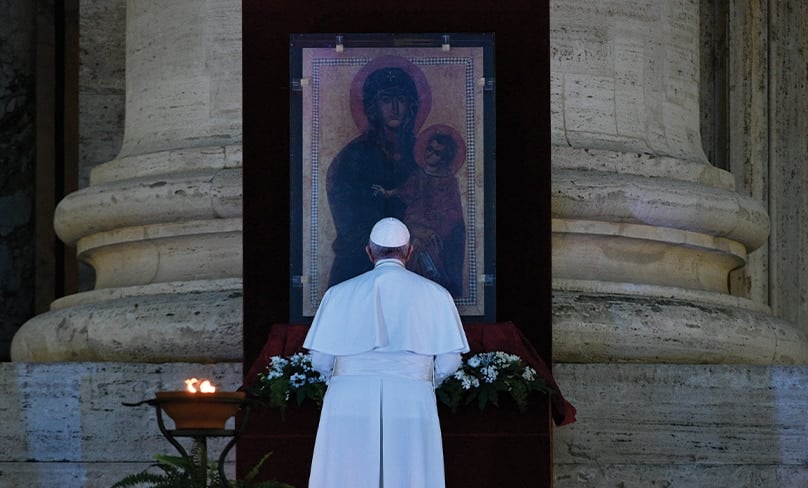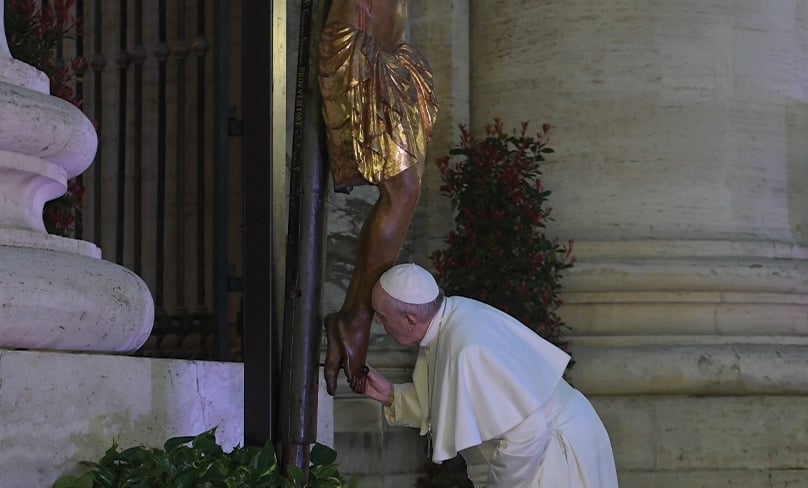
“Dear Father, I watched Pope Francis’ wonderful hour of prayer on 27 March and was struck by the beautiful crucifix and image of Our Lady behind him. Do they have any special significance?”
The crucifix and image of Our Lady, apart from being beautiful, are in fact very old and have great significance in the context of the present worldwide coronavirus pandemic.
The crucifix was that of San Marcello. It is of the Sienese school and dates to the 14th Century.
It normally hangs above the tabernacle in the church of San Marcello al Corso in Rome and is considered by many to be the most realistic model of the crucifixion in Rome. A number of miracles have been attributed to it.
The first dates to 1519 when the church of San Marcello caught fire on the night of 22-23 May and was completely destroyed.
At dawn the people rushed to the church to find only the outer walls standing and everything inside destroyed except the crucifix, which was still hanging above the altar with an oil lamp burning beneath it, although deformed by the heat.
Soon some of the people began to gather every Friday night at dusk to pray and light lamps at the feet of the cross. This gave rise to the Confraternity of the Holy Crucifix, which still exists today.
Another miraculous event took place three years later and relates to a health crisis not unlike our present one.
In 1522 a great plague struck Rome, so severe that it was feared no one would survive. Mindful of the miracle of the crucifix saved in the fire, the friars of the Servants of Mary decided to take the crucifix in a penitential procession from the church of San Marcello to St Peter’s Basilica to pray for an end to the plague. It was led by Spanish Cardinal Raimondo Vich, bishop of Valencia and Barcelona.
The authorities, fearing the risk of contagion, tried to stop the religious procession, but the people did not accept the warning and accompanied the crucifix through the streets of the city in large numbers.
The chronicles of the time relate that the procession lasted from 4-20 August, more than two weeks.
The reason it took so long is that, as the procession advanced, the plague receded so that each district tried to hold on to the sacred image as long as possible.

When it returned to San Marcello, the plague had completely ceased and Rome was saved. Since 1650, the miraculous crucifix has been taken to St Peter’s on the occasion of each Holy Year.
The image of Our Lady used by Pope Francis was the ancient and much loved icon of Our Lady, Salus Populi Romani, which is kept in the Lady Chapel of the Basilica of St Mary Major in Rome. The title Salus Populi Romani means literally “health” or “salvation” or “protectress” of the Roman people.
The actual origin of the image is uncertain. One tradition has it that it was taken to Rome by St Helena, the mother of the emperor Constantine in the Fourth Century.
It is said that it was Pope Liberius (352-366) who hung the image in the newly completed Basilica of St Mary Major.
According to a pious tradition, the icon was instrumental in saving Rome from the ravages of a devastating plague during the pontificate of Pope St Gregory the Great (590-604).
Pope Gregory carried the image in a solemn penitential procession through the streets of the city during the Easter season, praying for an end to the plague.
When the procession reached the Mausoleum of Hadrian, a choir of angels was heard singing the Resurrection hymn “Queen of Heaven, rejoice”. The Pope immediately added, “Pray for us to God, alleluia”.
At that point an angel, believed to be St Michael, appeared above the Mausoleum putting his sword back in its scabbard, as if indicating that the plague would cease, as in fact it did.
The Mausoleum is now known as the Castel Sant’Angelo, the Castle of the Holy Angel. It is located along the Tiber River, very near St Peter’s Basilica.
Since both the crucifix and the icon of Our Lady were instrumental in ending plagues many centuries ago, Pope Francis chose to use them in the hour of prayer for an end to the present pandemic.
We can join him and the Church around the world in praying to Our Lord and Our Lady for an end to this crisis.
